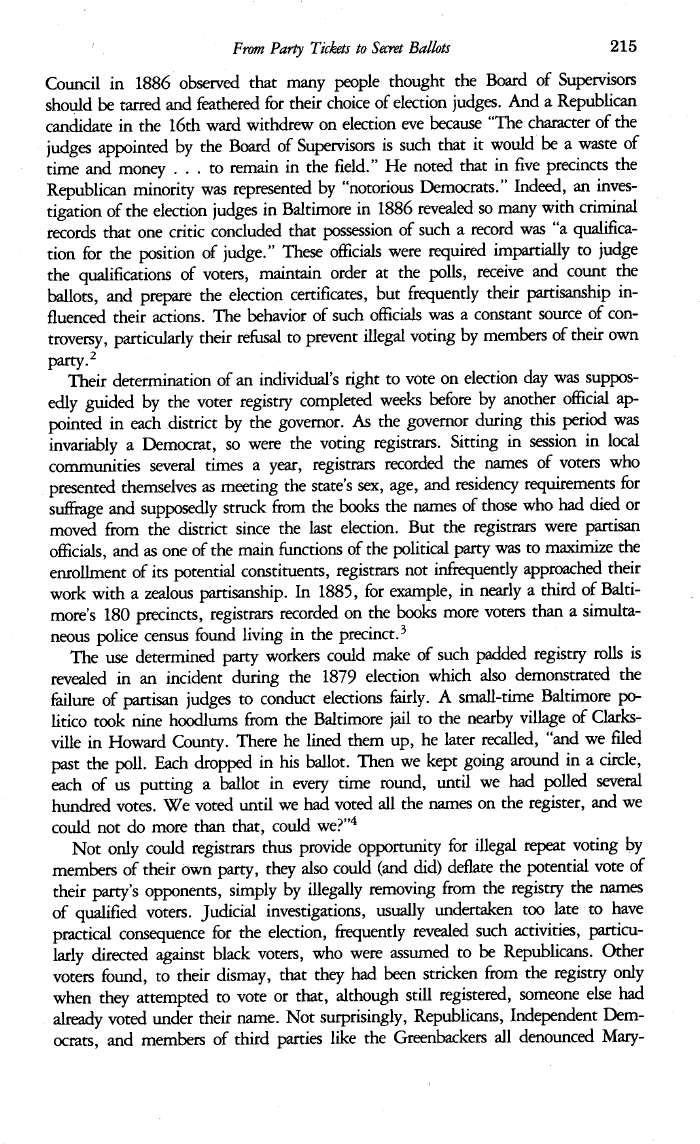|
From Party Tickets to Secret Ballots 215
Council in 1886 observed that many people thought the Board of Supervisors
should be tarred and feathered for their choice of election judges. And a
Republican
candidate in the 16th ward withdrew on election eve because "The character
of the
judges appointed by the Board of Supervisors is such that it would be a
waste of
time and money . . . to remain in the field." He noted that in five
precincts the
Republican minority was represented by "notorious Democrats." Indeed, an
inves-
tigation of the election judges in Baltimore in 1886 revealed so many with
criminal
records that one critic concluded that possession of such a record was "a
qualifica-
tion for the position of judge." These officials were required impartially
to judge
the qualifications of voters, maintain order at the polls, receive and
count the
ballots, and prepare the election certificates, but frequently their
partisanship in-
fluenced their actions. The behavior of such officials was a constant
source of con-
troversy, particularly their refusal to prevent illegal voting by members
of their own
party-2
Their determination of an individual's right to vote on election day was
suppos-
edly guided by the voter registry completed weeks before by another
official ap-
pointed in each district by the governor. As the governor during this
period was
invariably a Democrat, so were the voting registrars. Sitting in session in
local
communities several times a year, registrars recorded the names of voters
who
presented themselves as meeting the state's sex, age, and residency
requirements for
suffrage and supposedly struck from the books the names of those who had
died or
moved from the district since the last election. But the registrars were
partisan
officials, and as one of the main functions of the political party was to
maximize the
enrollment of its potential constituents, registrars not infrequently
approached their
work with a zealous partisanship. In 1885, for example, in nearly a third
of Balti-
more's 180 precincts, registrars recorded on the books more voters than a
simulta-
neous police census found living in the precinct.3
The use determined parry workers could make of such padded registry rolls is
revealed in an incident during the 1879 election which also demonstrated the
failure of partisan judges to conduct elections fairly. A small-time
Baltimore po-
litico took nine hoodlums from the Baltimore jail to the nearby village of
Clarks-
ville in Howard County. There he lined them up, he later recalled, "and we
filed
past the poll. Each dropped in his ballot. Then we kept going around in a
circle,
each of us putting a ballot in every time round, until we had polled several
hundred votes. We voted until we had voted all the names on the register,
and we
could not do more than that, could we?"4
Not only could registrars thus provide opportunity for illegal repeat
voting by
members of their own party, they also could (and did) deflate the potential
vote of
their party's opponents, simply by illegally removing from the registry the
names
of qualified voters. Judicial investigations, usually undertaken too late
to have
practical consequence for the election, frequently revealed such
activities, particu-
larly directed against black voters, who were assumed to be Republicans.
Other
voters found, to their dismay, that they had been stricken from the
registry only
when they attempted to vote or that, although still registered, someone
else had
already voted under their name. Not surprisingly, Republicans, Independent
Dem-
ocrats, and members of third parties like the Greenbackers all denounced
Mary-
|

